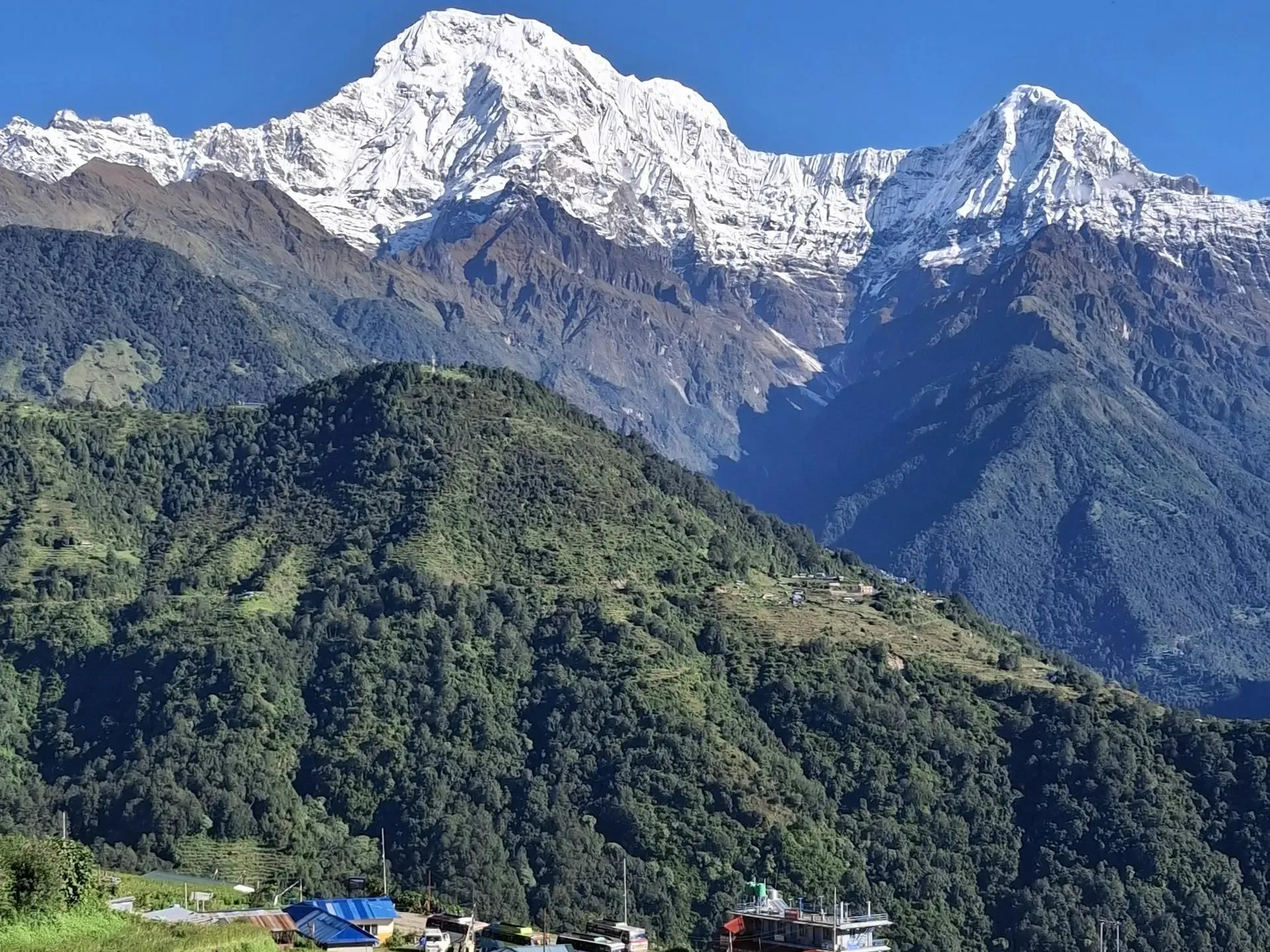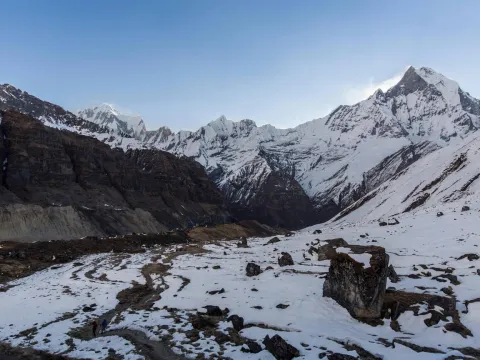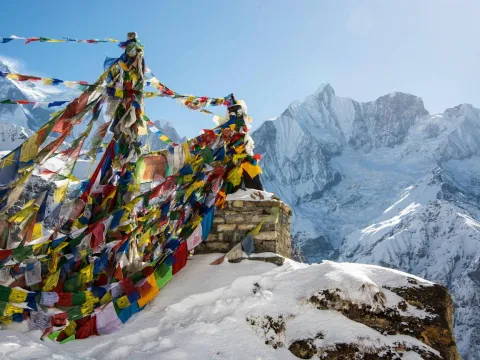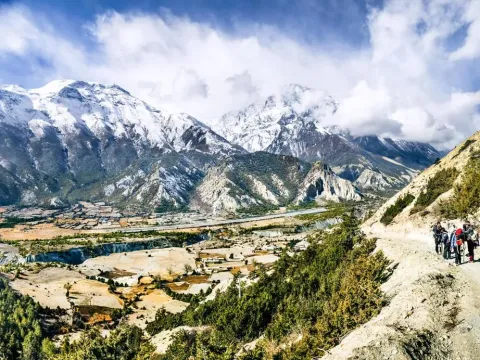The Annapurna Base Camp Trek (ABC Trek) is one of the most popular treks in Nepal, renowned for its stunning views of the Annapurna Massif, diverse la...

The Annapurna Base Camp (ABC) Trek and the Annapurna Circuit Trek are two of Nepal’s most iconic Himalayan adventures—but they offer very different experiences in terms of duration, difficulty, altitude, and scenery.
The ABC Trek is shorter and more direct, typically completed in 7 to 12 days, and takes you straight into the heart of the Annapurna Sanctuary. With a maximum altitude of 4,130 meters, it's well-suited for beginners or those with limited time, offering up-close mountain views, Gurung cultural villages, and a comfortable ascent profile.
In contrast, the Annapurna Circuit Trek is a longer, high-altitude journey that can take 15 to 21 days, reaching up to 5,416 meters at Thorong La Pass. It traverses a wide variety of landscapes and ethnic regions, from subtropical forests to Tibetan-influenced highlands, making it ideal for experienced trekkers seeking challenge, diversity, and deeper immersion.
Ultimately, your choice depends on your time, fitness, and adventure goals—and both promise an unforgettable Himalayan experience.
The Annapurna region is one of the most celebrated trekking destinations in the world—and for good reason. Nestled in central Nepal, it offers an extraordinary blend of breathtaking Himalayan scenery, diverse ecosystems, and rich cultural experiences within a relatively accessible trekking network. Towering peaks like Annapurna I (8,091 m), Machapuchare (Fishtail), and Dhaulagiri provide a constant backdrop as trails wind through lush forests, terraced farmlands, alpine valleys, and remote highlands.
But it’s not just the natural beauty that draws trekkers—it's also the opportunity to engage with Nepal’s ethnic communities. The region is home to Gurung, Thakali, Manangi, and Magar peoples, each with their own languages, traditions, and hospitality. Whether you're staying in a teahouse in Ghandruk or visiting a monastery in Manang, the Annapurna region offers deep cultural connection along with physical adventure.
Add to that the well-developed trail infrastructure, variety of trekking options (from short to long, easy to strenuous), and supportive local services, and you have a trekking destination that’s as welcoming as it is awe-inspiring. Whether you're new to the Himalayas or returning for your next challenge, the Annapurnas never disappoint.
The Annapurna region of Nepal is one of the most spectacular and diverse trekking destinations in the world. With towering snow-capped peaks, terraced hillsides, ancient villages, and vibrant local cultures, this region offers a trekking experience that goes far beyond just walking through mountains. Whether you're a first-time trekker or an experienced adventurer, the Himalayas captivate with their raw beauty, spiritual atmosphere, and the incredible hospitality of the Nepalese people.
At Explore Holiday Nepal, we specialize in guiding travelers through this majestic region, ensuring a safe, enjoyable, and unforgettable journey. Two of the most popular treks in the Annapurna region are the Annapurna Base Camp (ABC) Trek and the Annapurna Circuit Trek. While both offer breathtaking scenery and cultural encounters, they differ in terms of difficulty, duration, terrain, and overall experience. This guide will help you understand the unique features of each trek so you can decide which is the perfect adventure for you.
Annapurna Base Camp (ABC) Trek
The Annapurna Base Camp Trek is a moderately challenging journey that takes you into the heart of the Annapurna Sanctuary. Starting from the lush lowlands near Pokhara, the trail ascends through rhododendron forests, traditional Gurung villages, and terraced fields before reaching the spectacular amphitheater of mountains at Annapurna Base Camp. Surrounded by peaks over 7,000 meters, including the iconic Annapurna I (8,091 m), this trek offers one of the most awe-inspiring settings in the Himalayas.
The ABC trek typically takes 7 to 12 days, depending on your starting point and pace. The maximum elevation reached is around 4,130 meters (13,550 feet), which makes it more accessible for trekkers who are concerned about altitude. The route is well-established with comfortable teahouse accommodations along the way, making it a great choice for those who want a classic Himalayan trek with a shorter time commitment and less strenuous terrain than higher altitude treks.
Annapurna Circuit Trek
The Annapurna Circuit is one of the most legendary trekking routes in the world, known for its dramatic landscapes and incredible diversity. The trail circles the Annapurna Massif, passing through subtropical forests, alpine valleys, Tibetan-style villages, and high mountain deserts. It is a journey through both geography and culture, offering glimpses into the lives of different ethnic communities such as the Gurung, Manangi, and Thakali people.
This trek typically takes 15 to 21 days, covering a distance of 160 to 230 kilometers (100 to 145 miles) depending on your route. One of the trek’s most thrilling highlights is crossing Thorong La Pass (5,416 meters / 17,769 feet), a challenging but rewarding ascent that offers panoramic views across the Himalayas. Due to its length and the elevation, the Annapurna Circuit is more demanding than the ABC trek and better suited for trekkers with a good level of fitness and a sense of adventure. Despite its challenge, it remains one of the most fulfilling treks in Nepal, offering unmatched variety in both scenery and experience.
Major Highlights of Annapurna Base Camp (ABC) Trek
Major Places of Annapurna Base Camp (ABC) Trek
Major Highlights of Annapurna Circuit Trek
Major Places of Annapurna Circuit Trek
Annapurna Base Camp Trek: A Journey into the Heart of the Mountains
The Annapurna Base Camp (ABC) Trek offers a classic Himalayan trekking experience that showcases a stunning blend of verdant valleys and towering alpine scenery. The journey begins in the subtropical lowlands near Pokhara, where trekkers pass through lush forests filled with bamboo, oak, and rhododendron. These lower sections are rich in greenery, especially during spring when rhododendrons bloom in vibrant shades of red and pink, creating a colorful contrast with the surrounding landscape.
As the trail ascends, the environment transitions dramatically from forested hills to the stark, high-altitude terrain of the Annapurna Sanctuary. Here, trekkers are surrounded by a natural amphitheater of Himalayan peaks including Annapurna I, Hiunchuli, Machapuchare (Fishtail), and Annapurna South. The final approach to Annapurna Base Camp offers unmatched panoramic views as you walk directly into the heart of the mountains. The scale and closeness of these massive peaks create an almost surreal experience, making ABC one of the most visually rewarding short treks in Nepal.
Annapurna Circuit Trek: A Journey Across Climate Zones and Cultures
The Annapurna Circuit Trek is renowned for its dramatic variation in landscapes, arguably offering the most diverse scenery of any trek in Nepal. Beginning in the subtropical forests of the Marsyangdi River Valley, the route climbs gradually through fertile farmland, waterfalls, and lush pine forests. As trekkers ascend, the environment shifts to alpine meadows and eventually to the dry, desert-like terrain of Manang and Lower Mustang, areas that are heavily influenced by Tibetan culture and geography.
One of the trek's most spectacular visual highlights is the crossing of Thorong La Pass (5,416m), where trekkers are rewarded with panoramic views of the Annapurna, Dhaulagiri, and Manaslu ranges. After the pass, the descent into Muktinath and the Kali Gandaki Gorge reveals barren, windswept landscapes that sharply contrast with the lush lowlands where the trek began. This trek also passes through the world’s deepest gorge and can include side trips to Tilicho Lake, a striking high-altitude lake set against a stark alpine backdrop. The diversity in terrain—from subtropical jungle to Himalayan desert—makes the Annapurna Circuit a journey through multiple worlds in a single trek.
Annapurna Base Camp Trek: Moderate Challenge with Manageable Altitude
The Annapurna Base Camp (ABC) Trek is considered a moderate trek, making it suitable for trekkers with average fitness levels, including first-timers with some preparation. The total trekking duration ranges from 7 to 12 days, depending on the chosen route and starting point. The maximum altitude reached is 4,130 meters (13,550 feet) at Annapurna Base Camp, which is high enough to require some acclimatization but generally low-risk for serious altitude sickness when ascended gradually.
The daily hikes typically range from 4 to 6 hours, with a steady ascent through rolling hills, stone staircases, and forest trails. While there are sections with steep climbs—particularly before reaching Chhomrong, Deurali, and MBC—the elevation gain is more gradual compared to high-altitude treks. The ABC trek allows for shorter travel days and rest points, making it accessible to active travelers, families, and trekkers seeking a fulfilling Himalayan adventure without extreme physical strain.
Annapurna Circuit Trek: Demanding and Diverse, Ideal for Fit Trekkers
In contrast, the Annapurna Circuit Trek is a more physically demanding adventure due to its longer duration, greater distances, and high-altitude terrain. The trek spans 15 to 21 days and covers a distance of 160 to 230 kilometers (100 to 145 miles) depending on the route and side trips. The highest point is Thorong La Pass at 5,416 meters (17,769 feet)—a significant elevation that poses a real challenge and requires careful acclimatization.
Trekkers should be prepared for 6 to 8 hours of hiking per day, often on rugged trails with steep ascents and descents. The crossing of Thorong La Pass involves an early morning start in cold conditions and a long climb over rocky, snow-covered paths. This trek is best suited for those with good cardiovascular fitness and some prior trekking or hiking experience. That said, with proper pacing and rest days, many determined and well-prepared adventurers—regardless of age—can successfully complete the circuit.
Annapurna Base Camp Trek: Gurung Traditions and Village Hospitality
The Annapurna Base Camp (ABC) Trek offers rich opportunities for cultural immersion, particularly through interactions with the Gurung community—one of Nepal’s most prominent ethnic groups in the central hills. As you trek through picturesque villages like Ghandruk, Chhomrong, and Landruk, you'll encounter traditional stone houses, prayer flags, Buddhist stupas, and small community-run museums that reflect the daily life and customs of the Gurung people.
These villages are known for their warmth and hospitality. Trekkers often have the chance to enjoy homemade dal bhat meals, local dances, and traditional attire. Many of the Gurungs have served in the British or Indian Gurkha regiments, and you'll find strong influences of discipline, pride, and hospitality in their communities. The ABC trek allows trekkers to connect more intimately with village life, especially in the early stages of the journey where agriculture and local culture dominate the landscape.
Annapurna Circuit Trek: A Cross-Cultural Himalayan Journey
The Annapurna Circuit Trek is a remarkable journey not only for its natural diversity but also for the rich mosaic of cultures encountered along the route. The trek begins in the lush mid-hills inhabited by Gurung and Magar communities, then ascends into the Buddhist-influenced regions of Manang and Mustang, where you'll engage with Manangi and Thakali cultures. These groups have Tibetan roots, and their villages feature chortens (stone shrines), mani walls (prayer stones), and centuries-old monasteries.
In Manang, you’ll feel the transition into high-altitude Tibetan culture, where yak herding, barley farming, and salt trading traditions still persist. In Muktinath, you'll encounter Hindu and Buddhist pilgrims visiting the sacred Muktinath Temple, a powerful spiritual site that draws worshippers from across South Asia. Further along, in Marpha, you'll experience the refined culture of the Thakali people, known for their apple orchards, beautiful white-washed houses, and one of the best regional cuisines in Nepal. The circuit's breadth allows for a deep, layered understanding of Nepal’s diverse ethnic heritage, often within a single day’s walk.
Spring and Autumn: The Ideal Seasons for Both Treks
For both the Annapurna Base Camp and Annapurna Circuit treks, the two most popular seasons are spring (March to May) and autumn (late September to November). These periods offer the best combination of stable weather, clear mountain views, and comfortable temperatures. However, the experience of each trek during these seasons differs slightly due to terrain and altitude.
In spring, the Annapurna Base Camp trek comes alive with rhododendron blooms, especially in lower regions like Ghandruk and Chhomrong. The weather is generally mild, and the skies are often clear in the morning, though occasional afternoon clouds are common. Snow remains at higher elevations near ABC, creating stunning contrasts in the landscape. Spring also brings warmer temperatures, which makes trekking comfortable even at altitude.
During autumn, both treks offer crisp air and crystal-clear visibility, especially after the monsoon has washed away dust and pollution. This season is perfect for panoramic mountain photography. The temperatures are cooler than spring, but not extreme, and the dry trails make for safer hiking conditions. Autumn is particularly popular on the Annapurna Circuit because the high pass at Thorong La is more easily crossed when there is minimal snow and wind.
How Weather Affects Each Trek Differently
The Annapurna Base Camp Trek, being shorter and lower in altitude (maximum 4,130 m), is more forgiving when it comes to seasonal challenges. Even in early winter (December), the trek is still possible with proper gear, though colder temperatures and snowfall at ABC can make conditions icy. The monsoon season (June to August), however, is less ideal due to heavy rain, slippery trails, and reduced visibility, although the lush greenery during this time is striking.
In contrast, the Annapurna Circuit Trek—with its high pass at Thorong La (5,416 m)—is highly sensitive to seasonal weather changes. In winter (late December to February), the pass is often snowbound and impassable, making the full circuit difficult or dangerous. During the monsoon, the lower section of the circuit becomes muddy and leech-prone, while landslides are a risk in some areas. However, the rain-shadow region of Mustang remains relatively dry, making parts of the Circuit (like Jomsom and Muktinath) still accessible in monsoon.
Overall, if you're aiming for the full Circuit including Thorong La, stick to spring or autumn. For ABC, there's more flexibility, and it can even be enjoyed in early winter with the right planning and support.
Annapurna Base Camp Trek: Convenient Access and Well-Serviced Route
One of the key advantages of the Annapurna Base Camp (ABC) Trek is its easy accessibility from Pokhara, Nepal’s second-largest city and a major tourism hub. Most trekkers begin the journey with a short flight or 6–8 hour drive from Kathmandu to Pokhara. From there, the trailhead starts at Nayapul, Ghandruk, or Jhinu Danda, depending on your route and itinerary. These starting points are reachable within 1–3 hours by road from Pokhara, making the ABC trek highly accessible even with limited time.
Accommodation on the ABC route is plentiful, with well-established teahouses (basic lodges) and guesthouses throughout the trail. These lodges provide hot meals, private or shared rooms, and basic amenities like Wi-Fi, hot showers (for a fee), and charging stations. The trail is also well-marked and supported by numerous local guides and porters, making it a convenient trek for both guided and independent travelers. With its shorter length, accessible altitude, and developed infrastructure, the ABC trek is logistically simple and easy to manage, especially for those new to Himalayan trekking.
Annapurna Circuit Trek: Longer Journey with Evolving Infrastructure
The Annapurna Circuit Trek starts further from Pokhara and Kathmandu, and its route logistics are more complex due to the length and elevation of the journey. The traditional starting point is Besisahar, about 6–7 hours by road from Kathmandu or Pokhara. From Besisahar, trekkers either begin walking or take a jeep to Chame or Dharapani, depending on road conditions and their preferred starting point. The end point of the trek is typically Jomsom, from where trekkers either fly or drive back to Pokhara via Tatopani or Ghorepani if including side trails.
The Circuit also has a robust network of teahouses, but the level of comfort can vary with altitude and remoteness. Higher altitude stops like Thorong Phedi and Yak Kharka may have more limited services compared to lower villages. In recent years, road construction has reached deeper into the Circuit, especially on the eastern side, allowing vehicle access to some areas that were once remote. While this has improved logistics, it has also led some trekkers to skip sections in favor of more scenic routes like Tilicho Lake or Nar-Phu Valley.
Support services are widely available across the circuit, but due to the trek’s greater remoteness and elevation, most trekkers choose to go with a registered guide and porter, especially for the high pass crossing. Proper planning is essential, as weather conditions, acclimatization, and transportation timing (especially flights from Jomsom) can impact the schedule.
Annapurna Base Camp Trek: Time-Efficient and Budget-Friendly
The Annapurna Base Camp (ABC) Trek is ideal for trekkers with limited time and a moderate budget. Most itineraries take 7 to 12 days, including arrival in and return from Pokhara. This shorter timeframe appeals to travelers on tight schedules who still want to experience high-altitude trekking and close-up mountain views.
In terms of cost, ABC is more budget-friendly due to its accessibility, shorter duration, and lower altitude. A typical budget for a guided trek ranges from $600 to $1,200 USD, depending on the level of service and group size. Independent trekkers may spend even less.
Estimated Costs for Annapurna Base Camp Trek:
Because the ABC trail stays below 4,200 meters, you don’t need expensive high-altitude gear or oxygen, and you can comfortably complete the trek with standard trekking equipment.
Annapurna Circuit Trek: Longer and More Resource-Intensive
The Annapurna Circuit Trek requires a greater time commitment and a higher budget due to its extended route and high-altitude challenges. Most itineraries last 15 to 21 days, with additional days needed for side trips like Tilicho Lake or for weather-related delays, especially at Thorong La Pass (5,416 m).
The overall cost reflects the longer duration, logistical complexity, and need for acclimatization. A fully guided trek typically costs between $900 and $1,800 USD, with independent trekkers still requiring a substantial budget due to food and transportation costs in remote areas.
Estimated Costs for Annapurna Circuit Trek:
Given the altitude and remoteness, trekkers should also plan for emergency funds or contingency costs, such as an extra rest day or a helicopter evacuation in extreme cases (usually covered by insurance if applicable).
In summary:
Annapurna Base Camp Trek: Moderate Altitude, Lower Risk
The Annapurna Base Camp (ABC) Trek reaches a maximum elevation of 4,130 meters (13,550 feet) at the base camp itself. While this altitude is significant, the risk of severe altitude sickness (Acute Mountain Sickness – AMS) is relatively low compared to higher treks in Nepal. The trail gradually ascends over several days, giving the body time to adapt, and there are plenty of rest points at lower elevations, especially in villages like Chhomrong (2,170 m) and Deurali (3,230 m).
Most trekkers can complete the ABC trek without the need for extra acclimatization days, although it's still essential to stay hydrated, pace yourself, and recognize early symptoms of AMS (headache, nausea, fatigue). Because the trail is shorter and descends quickly after reaching base camp, the risk window is relatively small. That said, trekkers should not underestimate the altitude and should always allow for flexibility if symptoms appear.
Annapurna Circuit Trek: High-Altitude Adventure with Real Acclimatization Needs
In contrast, the Annapurna Circuit Trek reaches much higher elevations, with the Thorong La Pass topping out at 5,416 meters (17,769 feet)—a serious altitude that poses a greater risk of AMS. This part of the trek involves steep elevation gain and thinner air, making proper acclimatization essential. Most itineraries include at least one rest/acclimatization day in Manang (3,540 m) to help the body adjust before ascending higher.
Due to the high pass and prolonged time spent at altitudes above 3,500 meters, trekkers are more exposed to potential symptoms of AMS. Common strategies include:
The need for more acclimatization days adds to the overall length of the trek, but it’s crucial for safety. Trekkers attempting Thorong La without proper preparation risk serious complications, and evacuation (often by helicopter) can be logistically challenging and expensive without insurance.
Altitude Summary:
| Trek | Acclimatization Days | AMS Risk Level | Notes |
| Annapurna Base Camp - 4,130 m | Optional | Moderate | Gradual ascent; less exposure time to high altitude |
| Annapurna Circuit - 5,416 m (Thorong La) | Required | High | Includes extended time above 3,500 m; acclimatization is essential |

The Annapurna Base Camp Trek (ABC Trek) is one of the most popular treks in Nepal, renowned for its stunning views of the Annapurna Massif, diverse la...

Annapurna is one of the most iconic and majestic mountain ranges in the world, renowned not only for its sheer height but also for its challenging cli...

Nepal is often called the ultimate trekking destination in the world, and for good reason. Nestled among the highest peaks on Earth, including Mount E...
